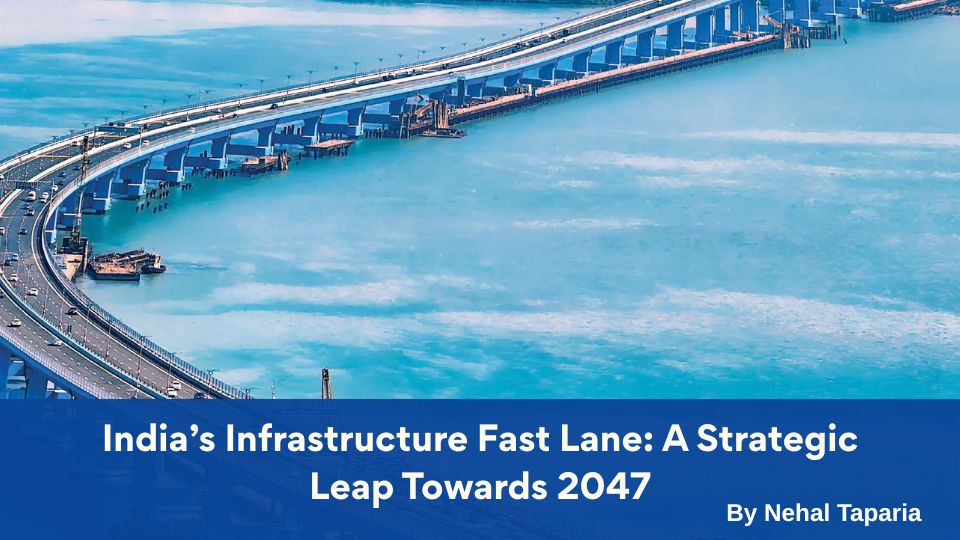India’s Infrastructure Fast Lane: A Strategic Leap Towards 2047

India’s Infrastructure Fast Lane: A Strategic Leap Towards 2047
India is embarking on an ambitious journey to reshape its infrastructure landscape, aiming to position itself as a developed nation by 2047. The government is prioritizing large-scale projects with extended timelines, such as bullet train corridors, expansive shipbuilding yards, multiple ports, and access-controlled highways. These initiatives are in alignment with the "Viksit Bharat 2047" vision, reflecting a commitment to modernize and advance India's infrastructure.
To expedite the execution of these projects, ministries and departments have been directed to streamline approvals and encourage public-private partnerships (PPP). The goal is to enhance economic growth through infrastructure development while moderating government spending. The Union Budget for 2025–26 has earmarked ₹11.21 lakh crore for infrastructure spending, underscoring the government's dedication to this transformative agenda.
Impact on the Indian Market
1. Economic Growth
The focus on infrastructure development is poised to accelerate India's economic growth. By improving connectivity and reducing logistics costs, these projects will enhance trade efficiency and attract investments, contributing to a robust economic environment.
2. Employment Opportunities
Large-scale infrastructure projects are labor-intensive and will generate numerous employment opportunities across various sectors, including construction, engineering, and logistics. This will not only provide jobs but also develop a skilled workforce, benefiting the economy in the long term.
3. Real Estate Development
Improved infrastructure, such as better roads and transportation systems, is likely to increase the attractiveness of real estate markets. Areas with enhanced connectivity may see a rise in property values and demand for both residential and commercial spaces.
4. Sectoral Growth
Key sectors such as logistics, manufacturing, and tourism are expected to experience growth due to improved infrastructure. Efficient transportation networks will facilitate smoother movement of goods and people, boosting these industries and contributing to overall economic development.
India's commitment to fast-tracking infrastructure projects reflects a strategic approach to achieving long-term economic goals. By prioritizing large-scale initiatives and fostering public-private collaborations, the country is laying the foundation for a prosperous and developed future.
By Nehal Taparia
This content is for educational and knowledge purposes only and should not be considered as investment or Trading advice. Please consult a certified financial advisor before making any investment or Trading decisions.
Our Recent FAQS
Frequently Asked Question &
Answers Here
1. What are the key infrastructure projects being prioritized?
The government is focusing on several mega-projects, including:
High-speed bullet train corridors
Large-scale shipbuilding yards
Development of multiple ports
Construction of access-controlled highways
These projects are designed to enhance connectivity, boost trade, and support economic growth.
2. How will these projects impact the economy?
The accelerated infrastructure development is expected to:
Reduce logistics costs, improving efficiency in trade and transportation.
Attract private and public investments, increasing the real investment rate from around 33.5% of GDP to 40% by 2035.
Create employment opportunities, fostering economic growth across various sectors.
3. What role will public-private partnerships play?
Public-private partnerships (PPP) will be encouraged for projects with high return on investment potential. This approach aims to leverage private sector expertise and funding, ensuring efficient project execution while moderating government expenditure.
4. How will these developments affect local markets?
The infrastructure boom is likely to stimulate growth in local markets by:
Enhancing connectivity, making regions more accessible for business and trade.
Attracting investments in real estate, manufacturing, and services.
Improving overall economic activity, leading to increased demand for goods and services.
Copyright © By The Stock Learning. Design & Developed by Techno Duniya










